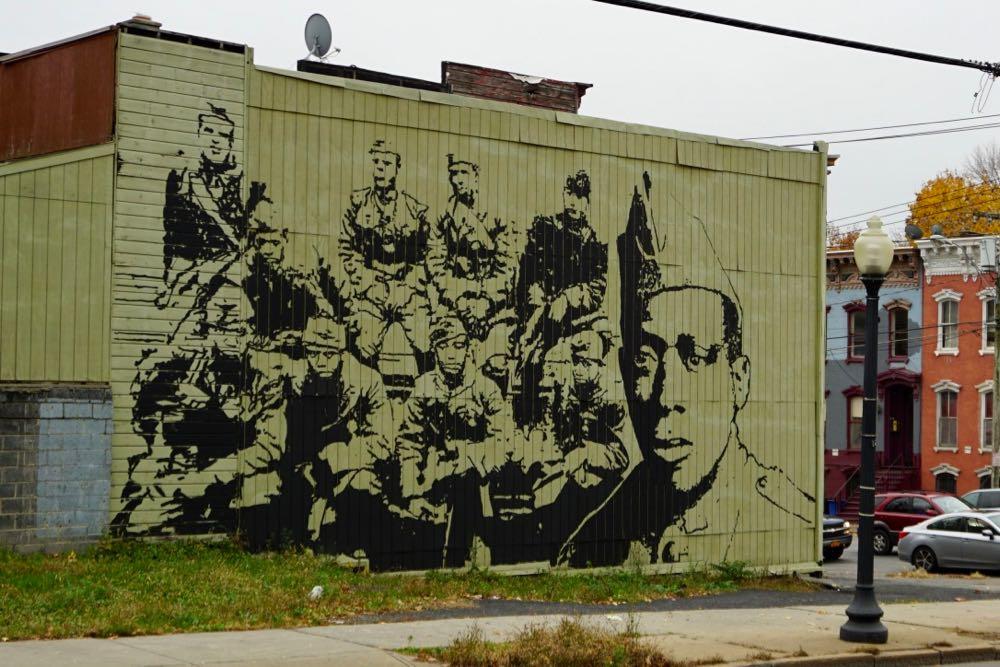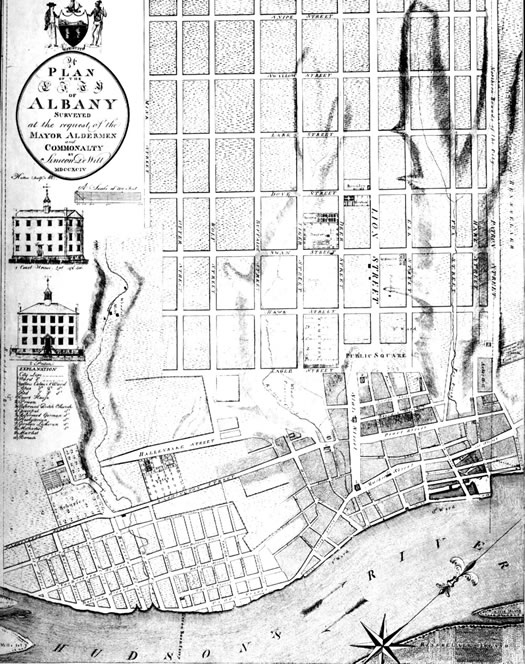A few of the 700some stories about the street names of Albany

Morton was named after Washington Morton, husband of Cornelia Schuyler Morton. (He was the son-in-law of Philip Schuyler.) As for the other street... is that Hawk or Hawke?
There are 785 streets in the city of Albany. And Erik Schlimmer has figured out the backstory for the name of almost every one of them.
That monumental effort -- it took him four years -- is collected in the new book Cradle of the Union: A Street by Street History of New York's Capital City. (Mentioned earlier.) And the result is like a bag of local history potato chips. Once you snack on a few of the street name histories it's hard to stop.
"In all place names -- street, the town they live in, a mountain range, a stream, a pond, a building -- there's usually a story behind the name," Schlimmer told us this week when we met up with him. "And the story is usually pretty good."
Here are a few of those important or funny or surprising or sometimes dramatic stories...
A gruesome backstory: Swartson Court
Schlimmer's research links the name of Swartson Court, a street off Whitehall Road, to the Swarts (earlier Schwartz) family, which had a farm there dating back to the 1800s. Specifically, the street was named after Edward Swarts in 1927. (This area of the city had been annexed from Bethlehem about a decade earlier.) By the 1940s, much of the land had been developed and Edward Swarts and his two sisters were having financial problems and facing eviction.
That's when the story takes a gruesome turn. In January 1944 Edward Swarts shot his two older sisters dead in the basement, burned the corpses, and then tried to burn the house down (unsuccessfully). Then he shot himself in the head. A neighbor found them roughly a week later. A fourth sibling, who had been living out of town, inherited the property and by that summer had divested himself of it.
"It's the only truly dark story in the book," Schlimmer told us.

An important backstory: Warren Street
Warren Street is likely named after the Revolutionary War figure Joseph Warren, who's also the namesake of Warren County.
Joseph Warren was a physician, a member of the early revolutionary government in Massachusetts, and a major general for the colonies during the Revolutionary War. He fought at Lexington and Concord, and was killed at the Battle of Bunker Hill after declining a commission as a general so he could go where the heaviest fighting was.
"It's an absolutely amazing story," Schlimmer said. "His body was buried on the battlefield and the British hated him so much that they dug it up, mutilated it, beheaded it, and threw it in a ditch. They hated Warren."
A funny backstory reveal: Renodin Drive
Schlimmer said he wasn't sure where to start in figuring out the backstory for Renodin Drive, which is off Hackett Boulevard near St. Peter's. So he got out a phone book, looked up the name, found one person, and picked up the phone.
"I called the guy and this old man answers, and I told him what I was doing. 'Have you ever heard of Renodin Drive?' He says, 'Yeah, it's named for me.'"
The man is Lyle Renodin, a former certified public accountant who's now 90 years old. "I didn't solve any other street names that way. It was pretty cool."
The other living person he encountered who has a street named for her: Rosemary E. Redmond, whose great uncle named Rosemary Drive in Bishop's Gate after his niece because she was the first baby born in the neighborhood.
A street not named after who you think it's named after: Buchanan Street
Buchanan Street sits along a handful of presidential names near North Allen and Manning Boulevard. So it was named for James Buchanan, right?
Schlimmer said his first thought was just that, but the story is more complicated. In the late 1800s a real estate agent Jessie Leonard (who himself has a street named for him) had wanted to the name the streets in this section of the city after brilliant engineers.
Up first: William Buchanan, who had designed locomotives for the New York Central Railroad and was a master mechanic in the company's West Albany machine shop. He designed the locomotive engine that was said to have been the first to go faster than 100 mph. So Leonard decides that Buchanan gets a street.
"And then he says, 'I don't think I know any other engineers,'" in Schlimmer's comic reenactment. "'Everybody's going to think it's named for the president, so I'll just name the streets for presidents.'"
Most obvious streets

Schlimmer said the easiest streets to figure out were the ones that practically solve themselves: Henry Johnson Boulevard, Clara Barton Drive, Dr. Martin Luther King Jr. Boulevard. "I went with a hunch on that one."
He said Founding Father street names are also usually easy to confirm.
"If you've got a long street that's Madison or Washington, you know it's them."
A change of identities

The 1794 Simeon De Witt map. If you head over to Wikipedia you can see a larger version in which the mammal names are clear. / via Wikipedia
A bunch of streets in Albany have changed names over time, some multiple times. Schlimmer said a prime example is what happened in the 1790s when Simeon De Witt changed a bunch of streets that had been named after the English.
That's when the "bird" streets show up -- Lark, Dove, Swan, and so on. And as Schlimmer highlights, there were also mammal streets: Mink, Otter, Wolf, "Buffaloe," Tiger, Deer, Lion, Fox, and Hare streets. The only mammal street that remains is Elk.
Schlimmer said in two cases De Witt took a shortcut, simply dropping the "e" off the end of Hawke and Wolfe streets -- named after British figures -- to make them Hawk and Wolf. (Wolf became Lydius, which in turn became Madison Ave.)
"He was either really lazy or really practical," Schlimmer said of De Witt.
The cutest name: Gingerbread Lane
There's a Gingerbread Lane that forms an arc between two points on John David Lane in the Crestwood neighborhood. The name was picked by Helen Picotte, the wife of the builder Clifford Picotte.
Schlimmer talked with William Picotte, their son who's now a senior vice president with the Picotte Companies, about how his mom selected the name: "I don't know, I guess she thought it was cute."
Clever names: Benson and Kent streets
Talking with Schlimmer, you can tell he revels in clever names or arrangements of names. An example: Benson and Kent streets.
Schlimmer said Benson is named after Egbert Benson, who represented New York in the Continental Congress, served as New York State attorney general, and was a prominent judge. And Kent Street -- running in parallel one block over -- is named after James Kent, a state Supreme Court judge who was mentored by Benson.
"The way that streets are named, some of the arrangements are quite clever," Schlimmer said. "I really like when two streets match up historically. Unless you just happen to know the history of these two men, you would never know they have a relationship in the street names. And I think that's pretty cool."
Favorite backstory: Henry Johnson Boulevard
When we asked Erik Schlimmer about his favorite street name backstory, he immediately responded Henry Johnson Boulevard.
"It's an amazing story from somebody who was, in every sense of the word, a hero."
____
AOA received a review copy of this book.
Hi there. Comments have been closed for this item. Still have something to say? Contact us.
Comments
Vying for cutest name: Teacup Circle, off New Scotland Ave. (and just a hop, skip, and a jump from Gingerbread Lane).
... said chrisck on Dec 11, 2018 at 6:14 PM | link
Henry Johnson Boulevard was originally called Northern Boulevard. The name was changed in the 1970s or 1980s.
... said Anna on Dec 13, 2018 at 8:55 AM | link
I'm partial to Krank Street myself...
... said ace on Dec 13, 2018 at 9:07 AM | link
Where can I buy this book
... said Harriet on Dec 13, 2018 at 10:19 AM | link
Any clues on West Van Vechten Street? Fascinating research!
... said E on Dec 13, 2018 at 10:38 AM | link
@Harriet: The book is available online via the link at the top. It also sounds like The Book House will have copies at some point.
... said Greg on Dec 13, 2018 at 10:55 AM | link
wondering what the origin of the name Brevator as in Brevator Street. Paul
... said Paul Bray on Dec 17, 2018 at 3:02 PM | link